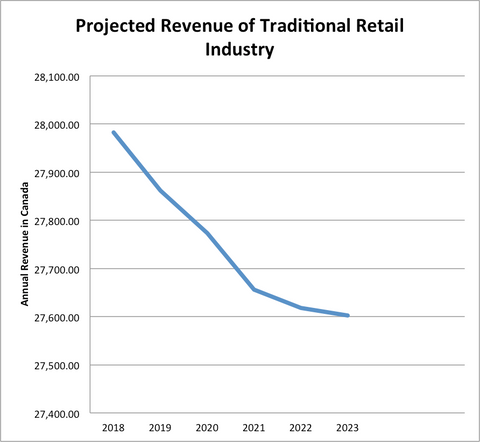By: Eric Chi
E-commerce has altered all aspects of traditional retail industry, including the selling of art. Over the past 5 years, online art sales have grown by annualized rate of 5.9% to $845million of 2016 revenue[i]. With rapid growth in technology, change in consumer behavior, and increased operational efficiency, e-commerce will mark the new age of art selling.
Reasons
Change in Traditional Retail
Traditionally retail industries are set to decrease by -1.4% in 2017 and -1.1% over the next 5 years[ii]. This decline is despite growth in retail industry’s key external factors: household disposable income. According to Statistics Canada, household disposable income grew by 11.2% over the past 3 years and has grown by 0.4% in first quarter 2017[iii]. In contrast, total revenue of major department stores have declined by -3.6% over the past 5 years. This shift is directly attributable to the continued growth of the over $22.1 trillion ecommerce industry.[iv] By 2022, 21.8% of all services is estimated to be conducted online[v]. As stated in our article “Death of Retailers”, online shopping has become an important channel for consumers and retailers.

Data from IBIS WORLD
Change in Consumer Preference
Art represents culture of luxury, exclusivity, and history. Like the fashion industry, the Internet has redefined the meaning of these words and changed the behavior of consumers. With emphasis on retail experience, traditional art galleries are scared of entering the e-commerce platform with the fear of diminishing luxury and exclusivity. Contrary to this belief, the selling of high-priced artworks dismisses this notion. An example is the selling of Jean-Michel Basquiat’s Sugar Ray Robinson painting for $24million through Instagram[vi]. Similar to fashion, online platform can be modified to suit brand images, consumer demographic, and retail experience.

Jean-Michel Basquiat's Sugar Ray Robinson
Study by Canada Post reveals that 76% of Canadian consumers shop online. This online shopping trend is not only limited to shopping for better prices but can also be applied to luxury products. Brands like Louis Vuitton and Gucci who also emphasize luxury and creativity demonstrates this. Despite rarely going on sale, Gucci and Louis Vuitton have used social media and e-commerce to create online platform that allow users to browse and customize products. The success of the online platforms resulted in 86% increase in online sales, which grew Gucci’s year on year sales by 48%[vii]. Growing up with technology, consumers are used to the quick, easy, and accessible nature of online shopping. With growing portions of the under 40 age group entering and being promoted in the workforce, the younger tech savvy population will become a bigger and wealthier consumer demographic. As consumers aged 20-34 are the main contributors to Online Art Sales (47%), e-commerce is the solution to adapting to changing consumers and maintaining the future sustainability of the art industry. Growing with changing consumer demographic will the key to survival even in the art industry.

Data from Statistics Canada
[i]http://clients1.ibisworld.com.myaccess.library.utoronto.ca/reports/us/industry/currentperformance.aspx?entid=5070
[iii] http://www5.statcan.gc.ca/cansim/a26?lang=eng&id=3800073
[iv] http://unctad.org/en/pages/newsdetails.aspx?OriginalVersionID=1281
[vi] https://www.bloomberg.com/news/articles/2016-12-21/want-to-sell-a-24-million-painting-fast-instagram-for-the-win
[vii] https://www.bloomberg.com/news/articles/2017-04-26/kering-shares-surge-after-gucci-s-strongest-growth-in-20-years